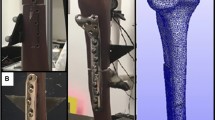Abstract
The Regeneration of bone defect is a major challenge in modern tissue engineering and regenerative medicine and its appropriate animal model is needed to translate research finding into clinical application. Animal long bone defect model requires a special bone fixation device which has verified mechanical stability and reproducibility. This study was more focused on developing a stable external fixator when working with bone defect model in rats. Further studies using larger animal experimental groups are necessary to explore reproducibility. The external fixation devices were composed of one aluminum block and four pins. The pins were made of various types (material: titanium, stainless steel; thickness: 1.2, 1.3, 1.4 mm; pitch: 0.5, 0.3 mm). For the evaluation of mechanical stability difference due to various types of the pins, we did two sets of mechanical measurements (mean axial stiffness) of the external fixators using blocks and excised rat femurs, and in vivo performance over a 6-week period. Under 8 mm offset, 1.2 mm thickness titanium pins were appropriate for rat femur defect model when pitch decreased from 0.5 mm to 0.3 mm. In addition, we can observe the pitch of the pin have a decisive effect on mechanical stability of the external fixator and expect this finding to be contributive to the related future research.
Similar content being viewed by others
References
Horner EA, Kirkham J, Wood D, Curran S, Smith M, Thomson B, et al. Long bone defect models for tissue engineering applications: criteria for choice. Tissue Eng Part B Rev 2010;16:263–271.
O’Loughlin PF, Morr S, Bogunovic L, Kim AD, Park B, Lane JM. Selection and development of preclinical models in fracture-healing research. J Bone Joint Surg Am 2008;90 Suppl 1:79–84.
Reichert JC, Saifzadeh S, Wullschleger ME, Epari DR, Schütz MA, Duda GN, et al. The challenge of establishing preclinical models for segmental bone defect research. Biomaterials 2009;30:2149–2163.
Aalami OO, Nacamuli RP, Lenton KA, Cowan CM, Fang TD, Fong KD, et al. Applications of a mouse model of calvarial healing: differences in regenerative abilities of juveniles and adults. Plast Reconstr Surg 2004;114: 713–720.
Gomes PS, Fernandes MH. Rodent models in bone-related research: the relevance of calvarial defects in the assessment of bone regeneration strategies. Lab Anim 2011;45:14–24.
Bosch C, Melsen B, Vargervik K. Importance of the critical-size bone defect in testing bone-regenerating materials. J Craniofac Surg 1998;9: 310–316.
Szpalski C, Barr J, Wetterau M, Saadeh PB, Warren SM. Cranial bone defects: current and future strategies. Neurosurg Focus 2010;29:e8.
Sung YD, Kim YH, Moon YM, Kim KJ, Kim YJ, Choi SY. The effects of the mixture of fetal bovine serum and poly-glycolic acid in rabbit calvarial model. J Korean Soc Plast Reconstr Surg 2007;34:298–304.
Bonnarens F, Einhorn TA. Production of a standard closed fracture in laboratory animal bone. J Orthop Res 1984;2:97–101.
Chao EY, Aro HT, Lewallen DG, Kelly PJ. The effect of rigidity on fracture healing in external fixation. Clin Orthop Relat Res 1989;(241):24–35.
Harrison LJ, Cunningham JL, Strömberg L, Goodship AE. Controlled induction of a pseudarthrosis: a study using a rodent model. J Orthop Trauma 2003;17:11–21.
Goodship AE, Watkins PE, Rigby HS, Kenwright J. The role of fixator frame stiffness in the control of fracture healing. An experimental study. J Biomech 1993;26:1027–1035.
Mark H, Bergholm J, Nilsson A, Rydevik B, Strömberg L. An external fixation method and device to study fracture healing in rats. Acta Orthop Scand 2003;74:476–482.
Strube P, Mehta M, Putzier M, Matziolis G, Perka C, Duda GN. A new device to control mechanical environment in bone defect healing in rats. J Biomech 2008;41:2696–2702.
Zhao Z, Yang D, Ma X, Zhao H, Nie C, Si Z. Successful repair of a critical-sized bone defect in the rat femur with a newly developed external fixator. Tohoku J Exp Med 2009;219:115–120.
Meinel L, Betz O, Fajardo R, Hofmann S, Nazarian A, Cory E, et al. Silk based biomaterials to heal critical sized femur defects. Bone 2006;39:922–931.
Schoen M, Rotter R, Schattner S, Mittlmeier T, Claes L, Vollmar B, et al. Introduction of a new interlocked intramedullary nailing device for stabilization of critically sized femoral defects in the rat: a combined biomechanical and animal experimental study. J Orthop Res 2008;26:184–189.
Author information
Authors and Affiliations
Corresponding author
Rights and permissions
About this article
Cite this article
Oh, D.Y., Choi, JY., Kim, K.J. et al. Development of an advanced external fixation device for rat femur defect. Tissue Eng Regen Med 12, 154–161 (2015). https://doi.org/10.1007/s13770-015-0080-9
Received:
Revised:
Accepted:
Published:
Issue Date:
DOI: https://doi.org/10.1007/s13770-015-0080-9




